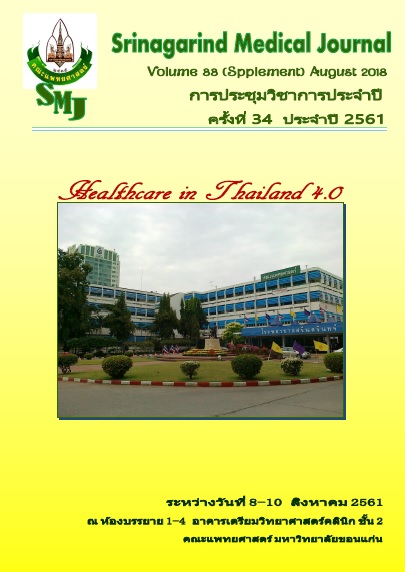Drug Use Review and Dose Appropriateness of New Oral Anticoagulants in Outpatients at Srinagarind Hospital
Keywords:
New oral anticoagulants (NOACs), drugs utilization review, potential drug-drug interactionsAbstract
Background and Objective: New oral anticoagulants (NOACs) is the new option of antithrombotics that contains several advantages over the warfarin use, however accumulating reports have shown some limitations or dose inappropriateness from its use. This study aimed to review the drug pattern and dose appropriateness of NOACs use during 1 year in outpatients at Srinagarind hospital.
Methods: The study was retrospective descriptive design. Data were collected from electronic database and medical records of patients who started NOACs using during December 2012 - December 2016.
Results: There were 103 cases with 475 prescriptions of NOACs use. The indications were nonvalvular atrial fibrillation (to reduce the risk of ischemic stroke and systemic embolism) for 75 cases (72.1%), and treatment and prevention of venous thromboembolism for 20 cases (19.2%) and 8 cases (7.7%), respectively. There was 1 case (1%) of off-label indication use for peripheral artery disease. The most prescribed NOACs was rivaroxaban (229 prescriptions, 48%), while the second and third were dabigatran (162 prescriptions, 34%) and apixaban (84 prescriptions, 18%). The three most prescribed of NOACs dosage regimen were dabigatran 110 mg twice daily (144 prescriptions, 30.3%), rivaroxaban 20 mg once daily (126 prescriptions, 26.5%), and rivaroxaban 15 mg once daily (96 prescriptions, 20.2%). Approximately 76% of patients were assessed renal function before starting NOACs, while 66% of patients were monitored renal function at least one time during NOACs use. Potential drug-drug interactions were found in 48 cases (46.6%) with 68 drug pairs. Most of them was concomitant use with antiplatelets (38.2%). The inappropriateness dose of NOACs were found in 22% of prescriptions which contains too low dose, too high dose, and contraindication use for 10%, 8% and 4%, respectively.
Conclusion: Most of NOACs use in outpatients at Srinagarind hospital was appropriate in terms of indication, dose and renal function monitoring. However, the lack of renal assessment/monitoring and the use in inappropriate dose were still found in some patients. Increasing awareness and management of NOACs utilization by healthcare team is suggested to improve the effectiveness of drug use in patients.
References
Kirchhof P, Benussi S, Kotecha D, Ahlsson A, Atar D, Casadei B, et al. 2016 ESC Guidelines for the management of atrial fibrillation developed in collaboration with EACTS. Eur Heart J 2016; 37: 2893–962.
PRADAXA® (dabigatran etexilate mesylate) capsules [package insert on internet]. Ridgefield (CT): Boehringer Ingelheim Pharmaceuticals, Inc. 2015 [updated Nov 20, 2015; cited Nov 30, 2017]. Available from: https://www.accessdata.fda.gov/drugsatfda_docs/label/2015/022512s 028lbl.pdf
XARELTO® (rivaroxaban) tablets [package insert on internet]. Titusville (NJ): Janssen Pharmaceuticals, Inc. 2017 [updated Oct 27, 2017; cited Dec 1, 2017]. Available from: https://www.accessdata.fda.gov/drugsatfda_docs/label/2017/022406s024lbl.pdf
ELIQUIS® (apixaban) tablets [package insert on internet]. Princeton (NJ): Bristol-Myers Squibb Company. 2017 [updated Nov 29, 2017; cited Dec 3, 2017]. Available from: https://www.accessdata.fda.gov/drugsatfda_docs/label/2017/202155s017lbl.pdf
Larock AS, Mullier F, Sennesael AL, Douxfils J, Devalet B, Chatelain C, et al. Appropriateness of prescribing dabigatran etexilate and rivaroxaban in patients with nonvalvular atrial fibrillation: a prospective study. Ann Pharmacother 2014; 48: 1258–68.
Sidman E, Probst LA, Darko W, Miller CD. Evaluation of dabigatran utilization and risk among hospitalized patients. Ann Pharmacother 2013; 48: 349–53.
Carley B, Griesbach S, Larson T, Krueger K. Assessment of dabigatran utilization and prescribing patterns for atrial fibrillation in a physician group practice setting. Am J Cardiol 2014; 113: 650–4.
Carter AA, Leblanc K, Woods A, Lowe D. Utilization of Dabigatran for Atrial Fibrillation at 3 Tertiary Care Centres. Can J Hosp Pharm 2015; 68: 369–77.
Jobski K, Enders D, Amann U, Suzart K, Wallander MA, Schink T, et al. Use of rivaroxaban in Germany: a database drug utilization study of a drug started in hospital. Eur J Clin Pharmacol 2014; 70: 975–81.
Isaacs AN, Doolin M, Morse C, Shiltz E, Nisly SA. Medication utilization evaluation of dabigatran and rivaroxaban within a large, multi-center health system. Am J Heal Pharm 2016; 73 (Suppl 1): S35–41
Tellor KB, Patel S, Armbruster AL, Daly MW. Evaluation of the appropriateness of dosing, indication and safety of rivaroxaban in a community hospital. J Clin Pharm Ther 2015; 40: 447–51.
Barra ME, Fanikos J, Connors JM, Sylvester KW, Piazza G, Goldhaber SZ. Evaluation of Dose-Reduced Direct Oral Anticoagulant Therapy. Am J Med 2016; 129: 1198–204.
Pattullo CS, Barras M, Tai B, McKean M, Donovan P. New oral anticoagulants: appropriateness of prescribing in real-world setting. Intern Med J 2016; 46: 812–8.
Whitworth MM, Haase KK, Fike DS, Bharadwaj RM, Young RB, MacLaughlin EJ. Utilization and prescribing patterns of direct oral anticoagulants. Int J Gen Med 2017; 10: 87–94.
Altay S, Yıldırımtürk Ö, Çakmak HA, Aşkın L, Sinan ÜY, Beşli F, et al. New oral anticoagulants-TURKey (NOAC-TURK): Multicenter cross-sectional study. Anatol J Cardiol 2017; 17: 353–61.
Lippi G, Mattiuzzi C, Cervellin G, Favaloro JE. Direct oral anticoagulants: analysis of worldwide use and popularity using Google Trends. Ann Transl Med 2017; 5: 322.
ประกาศคณะกรรมการพัฒนาระบบยาแห่งชาติ เรื่อง บัญชียาหลักแห่งชาติ พ.ศ. 2561 ประกาศ ณ วันที่ 4 มกราคม พ.ศ. 2561 คัดจากราชกิจจานุเบกษาเล่ม 135 ตอนพิเศษ 14 ง วันที่ 19 มกราคม 2561.
Heidbuchel H, Verhamme P, Alings M, Antz M, Diener H, Hacke W, et al. Updated European Heart Rhythm Association practical guide on the use of non-vitamin-K antagonist anticoagulants in patients with non-valvular atrial fibrillation: Executive summary. Eur Heart J 2017; 38: 2137–49.
Tatro DS. Drug interaction facts. St. Louis Missourit: Wolter Kluwer Health; 2014.


